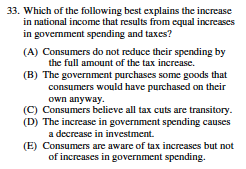2012 Macro Multiple Choice (Fiscal Policy)
Fiscal Policy Cheat Sheet here.
Answer - (B)
From the cheat sheet.
Answer - (B)
From the cheat sheet
Answer - (C)
From the cheat sheet
Answer - (C)
Understand that ann increase in Government Spending increases consumption which increases Aggregate Demand.
From the AD/AS cheat sheet here.
Answer - (A)
Post that answers this here.
Answer - (C)
If the budget deficit is increasing ,, it means that the government is spending and if the government is spending then the Real Interest Rate (RIR) is increasing.





























